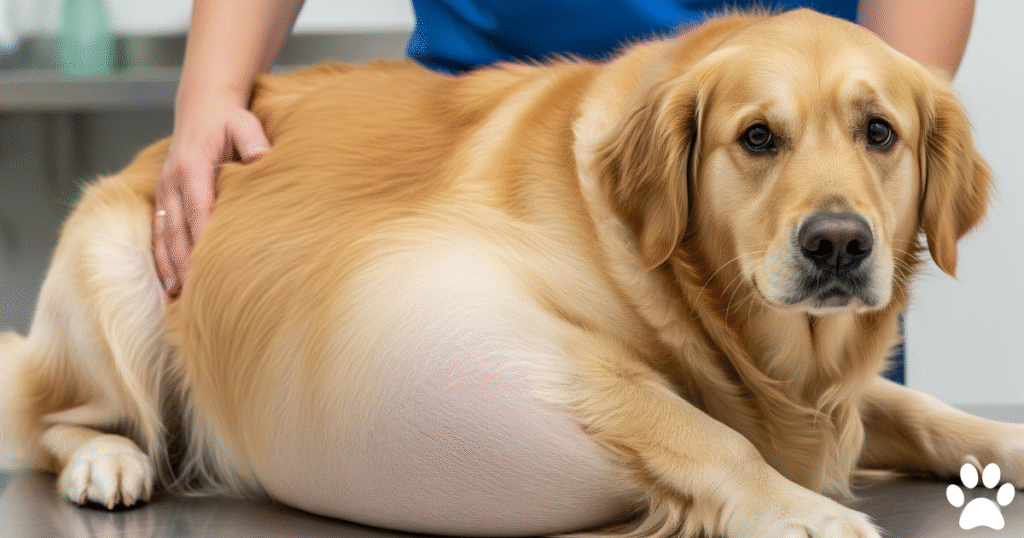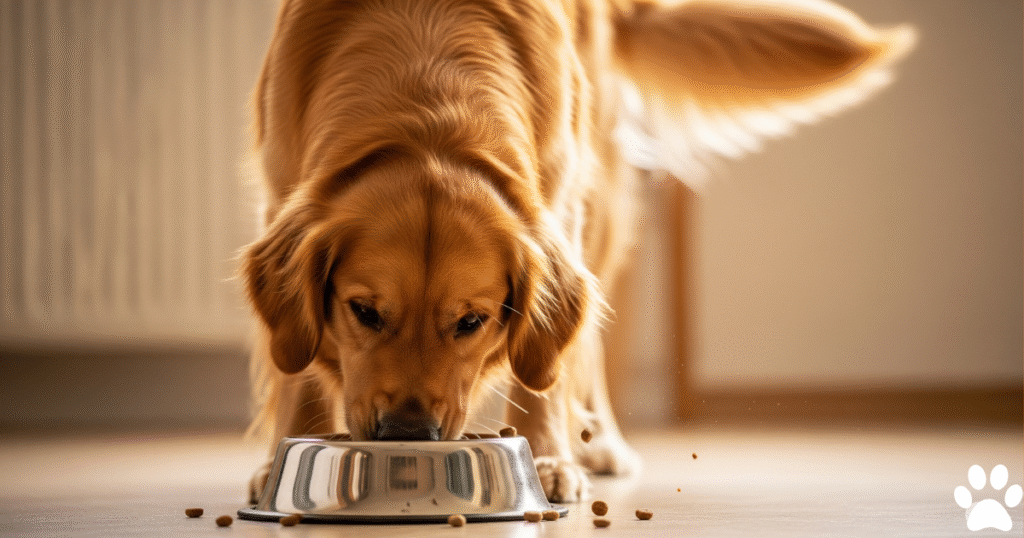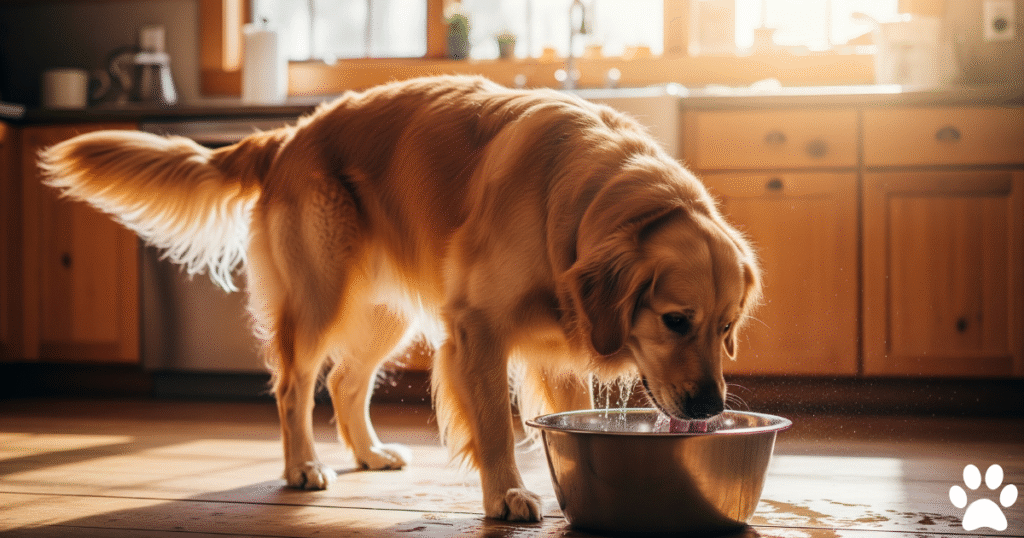Bloat in dogs is one of the most frightening and urgent medical situations a pet owner can face, especially in golden retrievers. This condition can be fatal within hours. Often referred to as the “silent killer,” bloat in dogs develops quickly and requires immediate action. Understanding the dog bloat timeline, from the first signs to life-threatening collapse, is critical to saving your dog’s life. Golden retrievers are one of the most vulnerable breeds due to their deep chests, genetic predisposition, and eating habits. However, many dog owners don’t know what bloat in dogs is, how quickly it can get worse, or what early symptoms to look out for. If left untreated, bloat in dogs can lead to internal damage, shock, and death within hours.
This comprehensive guide is for golden retriever owners who want to be informed, prepared, and proactive. We’ll look at Golden Retriever Health, why timing is critical (thanks to the dog bloat timeline), and what you can do to identify, reduce, and prevent the risk. Whether you’re a first-time dog owner or an existing Golden Retriever owner, understanding bloat in dogs can mean the difference between life and death.
Contents
- 1 Why Bloat in Dogs Is a Major Threat to Golden Retrievers
- 2 The Dog Bloat Timeline: From First Signs to Emergency
- 3 Recognizing Early Symptoms of Bloat in Dogs Before It’s Too Late
- 4 The Complete Guide to Guide to GDV: The Medical Root of Bloat in Dogs
- 5 Common Causes of Bloat in Dogs and How to Prevent It
- 6 Emergency Response: What to Do If Your Golden Retriever Has Bloat
- 7 How Vets Treat Bloat in Dogs Based on the Timeline
- 8 Tips for Preventing Bloat in Golden Retrievers
- 9 Avoid exercise before and after meals
- 10 Final Thoughts: Bloat in Dogs Doesn’t Have to Be a Death Sentence
Why Bloat in Dogs Is a Major Threat to Golden Retrievers
Golden retrievers are one of the most popular dog breeds, but they are also a large, deep-chested breed that is at high risk for bloat in dogs. The condition can occur in any dog, but is significantly more dangerous in breeds like golden retrievers due to their unique body type and temperament.
In short, bloat in dogs occurs when air or food quickly accumulates in the stomach, which can quickly lead to bloat in dogs and fatal complications. Many golden retriever owners underestimate how quickly this condition can progress from minor discomfort to a life-threatening emergency. The time frame for bloat in dogs is surprisingly short. In many cases, the stomach can twist in as little as 30 minutes after symptoms first appear, cutting off blood flow and causing shock. In this case, even a delay of a few hours can dramatically reduce the chances of survival – even with surgery. This is why bloat in dogs is often called the “silent killer.”
Golden retrievers are particularly at risk because:
- They often eat very quickly.
- They have a deep chest, which makes gdv more likely.
- They may have a genetic predisposition to gastrointestinal sensitivities.
The Dog Bloat Timeline: From First Signs to Emergency
When bloat in dogs occurs, especially in Golden Retrievers, time is of the essence. In a matter of hours, the disease can progress from little discomfort to potentially fatal. Therefore, it is crucial to understand the og bloat timeline and act promptly to save your dog’s life.
The First 30 Minutes – Subtle Signs Begin
The early stages of bloat in dogs may initially appear harmless. Your Golden Retriever may appear restless, pace back and forth, or attempt in vain to vomit. They may drool excessively or look at their stomach with concern. These symptoms are often mistaken for general restlessness or bloating, but they are warning signs of bloat in dogs.
What to Do: Monitor the situation closely. If these symptoms persist for more than 10 to 15 minutes, consider it a veterinary emergency and be prepared to go to the veterinary hospital immediately.
30 minutes to 2 hours – Make an appointment quickly
During this time, abdominal bloat in dogs can worsen rapidly. The abdomen may become visibly swollen or tense, and your dog may pant heavily, collapse, or show signs of extreme stress. In this case, abdominal bloat usually develops into life-threatening torsion, also known as VDG (more on this later).
What to do: Don’t wait. Take your dog to the nearest veterinarian as soon as possible. Every minute lost at this stage drastically reduces their chances of survival.
More than 2 hours – Serious risk of death
If your Golden Retriever is left untreated, their condition can rapidly deteriorate. They will go into shock, organ failure, and surgical interventions will become less effective. If your dog is left untreated for 2 hours, the risk of death from bloat increases dramatically. Knowing the time window for bloat in dogs is not only helpful, but it can also save lives. Have you ever wondered, “Is this serious?” The response to flatulence is always “yes.”
Recognizing Early Symptoms of Bloat in Dogs Before It’s Too Late
One of the most important factors in surviving bloat in dogs is early detection, especially in at-risk breeds like the Golden Retriever. Many owners mistake the early signs for mild stomach upset or restlessness, which unfortunately delays treatment in the critical stages of dog bloat timeline.
The Most Common Physical Symptoms
In the first 30 to 60 minutes of bloat in dogs, you may notice the following
- A noticeably swollen or distended abdomen
- Non-productive vomiting or gagging
- Excessive drooling
- Shallow or rapid breathing
These signs may show up rapidly and get worse over time. Because bloat in dogs progresses quickly, even one of these symptoms is cause for concern.
Behavior Changes to Watch Out For
Golden Retrievers often suffer from bloat:
- They appear restless, pacing, or crying.
- They look anxiously at their belly.
- They suddenly refuse food or water.
- They appear weak or disoriented.
These behavioral signs may appear before physical symptoms, so don’t ignore them. As bloat progresses in dogs, these behavioral patterns usually occur within the first critical hour.
How Golden Retrievers Can Hide Symptoms
Golden Retrievers are known for their cheerful and tolerant nature, which can sometimes cause them to hide their pain. This makes it even more difficult to detect bloat in dogs in the early stages. This is why Golden Retriever owners need to be especially vigilant. By the time more obvious symptoms appear, your dog may already be halfway through a bloat episode and approaching the danger zone.
The Complete Guide to Guide to GDV: The Medical Root of Bloat in Dogs
While bloat in dogs in dogs can indicate any abnormal swelling, the real danger lies in a specific and potentially fatal condition called Gastric Dilatation-Volvulus (GDV). In this stage of GDV, the dog’s stomach not only fills with gas or fluid, but also twists, cutting off the blood supply to vital organs. This twisting prevents the dog from vomiting or releasing gas, which leads to rapid internal damage. Without emergency surgery, most dogs do not survive GDV for more than a few hours.
GDV is a serious problem for Golden Retrievers due to their deep chests and tendency to eat quickly. In fact, they are one of the breeds most often taken to the vet. GDV in dogs usually occurs within 30 minutes to two hours of the first signs of GDV – every minute counts. The earlier a volvulus is diagnosed, the better the chance of survival. After two hours, treatment becomes increasingly difficult and expensive. It is the fatal stage of bloat in dogs and often occurs earlier than expected.

Common Causes of Bloat in Dogs and How to Prevent It
Understanding the most common causes of bloat in dogs is essential for prevention, especially for Golden Retriever owners. This breed’s deep chest, eagerness to eat, and high energy levels make them more prone to bloat than smaller or flatter breeds. Although the precise etiology of canine bloat is frequently still unknown, researchers and veterinarians have found a number of significant risk factors. By knowing and avoiding these triggers, you can take steps before your dog develops bloat.
Eating Too Fast
Golden Retrievers tend to eat enthusiastically. However, eating too fast can cause their stomachs to quickly fill with air and food, leading to bloat. A slow feeder or food puzzle can greatly reduce this risk.

Exercising Before or After Meals
Too much exercise before or after meals increases the risk of bloat in dogs. Give your Golden Retriever at least an hour to rest after meals before playing fetch or walking him.

Overeating or drinking too much water at one time
Large meals and sudden water intake can cause abnormal bloat. Spread your Golden Retriever’s meals into two or more meals per day and provide regular but moderate access to fresh water. (Learn more about bloat in dogs in our guide to hydration.)

Genetic and Environmental Factors
Some Golden Retrievers have a genetic predisposition to bloat due to inherited traits such as a broad chest, weak ligaments, or a stress-prone nature. Your dog may be at greater risk if either a parent or sibling has bloat. Avoiding these habits can greatly reduce the risk of bloat in dogs, protect your Golden Retriever, and prolong the critical dog bloat timeline after symptoms begin.
Emergency Response: What to Do If Your Golden Retriever Has Bloat
If you suspect your bloat in dogs, especially a Golden Retriever, treat it like a medical emergency, because it is. The difference between life and death often depends on how quickly you react during the dog bloat timeline can quickly occur in your dog.
Step 1: Recognize the Signs of an Emergency
If your dog is showing symptoms such as bloating, non-productive vomiting, excessive drooling, restlessness, or visible discomfort, don’t wait. These are all signs of bloat in dogs, and they usually occur within the first 30 to 60 minutes of the volvulus.
Step 2: Call Your Vet Immediately
Don’t try home remedies. Call your veterinarian or the nearest 24-hour emergency clinic and explain that you are traveling with a suspected bloat in dogs. Time is of the essence. Making a call in advance will enable you to have diagnostic and surgical instruments available for prompt action.
Step 3 – Minimize Movement and Transport Safely
Keep your Golden Retriever calm during transport. Do not encourage walking, jumping, or excessive exercise, as this may worsen bloat in dogs, if it has already progressed to a GDV. If necessary, carefully load your dog into the car.
Remember that bloat in dogs, can worsen quickly over the course of 1-2 hours. Your dog’s chances of surviving stomach torsion improve with immediate treatment. Trust your instincts – it is always better to catch the problem early and find out everything is okay than to wait too long.
How Vets Treat Bloat in Dogs Based on the Timeline
When your Golden Retriever arrives at the clinic showing bloat in dogs, every second counts. Your vet’s response often depends on dog bloat timeline to develop GDV, so early detection and prompt transport are critical. Early veterinary care is the most effective way to survive bloat in dogs. The faster you act, the more options your vet has — and the better your dog’s chances of survival.
Arrive within the first hour: Higher chance of survival
If your Golden Retriever arrives within the first 30 to 60 minutes of symptoms, your vet can quickly drain the stomach with a tube or needle. This allows time for diagnosis and preparation for any necessary surgery. At this point, the stomach may not have twisted, meaning GDV is not yet present and emergency surgery can be avoided.
Arrive within 1 to 2 hours: GDV is likely
After the first hour, the risk of GDV progressing to GDV increases, especially in Golden Retrievers. Veterinarians will stabilize your dog with IV fluids, oxygen, and medications before performing emergency surgery to decompress the stomach and assess internal damage. Time is of the essence — dogs treated within this time frame still have a good chance of survival, but the risk is significantly increased.
Arriving More Than 2 Hours: Critical and Complex
If your Golden Retriever arrives at the vet more than 2 hours after the bloat in dogs, complications such as tissue death, shock, or sepsis may already be present. Surgery is possible, but the prognosis is uncertain. In some cases, part of the stomach or spleen may need to be removed, making recovery more difficult and uncertain.
Tips for Preventing Bloat in Golden Retrievers
While bloat in dogs can occur suddenly, many cases, especially in golden retrievers, can be minimized or prevented with effective care. Bloat prevention is the greatest defense in dogs, and some daily routines can significantly lower your dog’s risk of bloating.
Feed your golden retriever smaller meals more often
Instead of feeding him one large meal a day, split the meal into two or three smaller meals. Large meals expand the stomach and increase the risk of bloat in dogs, especially deep-chested breeds.
Use a slow feeder
Golden retrievers tend to eat quickly and swallow air along with their food. A slow feeder or puzzle feeder will help your dog eat more slowly and reduce air intake, a common cause of bloat in dogs.
Avoid exercise before and after meals
Never allow your Golden Retriever to run, play, or jump within an hour of eating. Physical activity combined with a full stomach is one of the biggest risk factors for bloat in dogs.
Pay attention to water intake, especially after meals.
While adequate hydration is important, too much water right after meals can contribute to water bloat in dogs. Offer your dog water regularly throughout the day, but in small amounts after meals.
Reduce stress and anxiety
A stressful environment and anxiety during mealtimes can lead to excessive salivation and poor digestion. Feed your Golden Retriever in a calm, stable environment to encourage relaxed eating behavior.
With these simple but effective tips, you can significantly reduce the risk of dangerous bloat in your golden retriever. Prevention only takes a few minutes – bloat can be life-threatening in a matter of hours.
Final Thoughts: Bloat in Dogs Doesn’t Have to Be a Death Sentence
Bloat in dogs is one of the most serious health risks for Golden Retriever owners, but it doesn’t have to be tragic. With the right knowledge, vigilance, and quick action, your dog has a good chance of survival. The key is to understand the dog bloat timeline. Every minute matters because bloat may be lethal in a matter of hours. From recognizing symptoms early and responding quickly to avoiding triggers, your role as a dog owner is critical.
Golden Retrievers, with their broad chests and insatiable appetites, are more likely to develop bloat. However, this risk can be greatly reduced with proper feeding routines, slow feeding, a calm environment, and regular medical checkups. Recognizing signs like restlessness, upset stomach, or non-productive vomiting can save your dog’s life. Also remember that bloat is not always preventable. So it’s equally important to have an emergency plan: find out where the nearest 24-hour vet is, act quickly, and trust your instincts. Being informed and proactive will not only prevent canine flatulence, but will also help your Golden Retriever live a long, healthy, and happy life.
Dr. Nabeel A.
Hi, I’m Dr. Nabeel Akram – a farm management professional by trade and a passionate Golden Retriever enthusiast at heart. With years of experience in animal science and livestock care, I’ve built a career around understanding animals—how they live, thrive, and bring value to our lives. This blog is a personal project born from that same passion, focusing on one of the most loyal and lovable breeds out there: the Golden Retriever. Whether I’m managing farm operations or sharing insights on canine health, behavior, and care, it all ties back to one core belief—animals deserve thoughtful, informed, and compassionate attention. Welcome to a space where professional expertise meets genuine love for dogs.
Facebook |


Links will be automatically removed from comments.